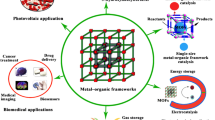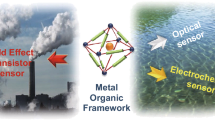Abstract
Controllable synthesis of micro-flower covalent organic frameworks (MFCOFs) with controllable size, monodisperse, spherical, and beautiful flower shape was realized by using 2,5-diformylfuran (DFF) and p-phenylenediamine (p-PDA) as building blocks at room temperature. High-quality MFCOFs (5 − 7 μm) were synthesized by controlling the kind of solvent, amounts of monomers, catalyst content, and reaction time. The synthesized MFCOFs possessed uniform mesopores deriving from the intrinsic pores of frameworks and wide-distributed pores belonging to the gap between the petals. The MFCOFs-packed solid-phase extraction (SPE) column shows adsorption capacity of about 8.85 mg g−1 for 2,4-dichlorophenol (2,4-DCP). The MFCOF-based SPE combined with the HPLC method was established for the determination of 2,4-DCP in environmental water. The linear range of this method is 20–1000 ng mL−1 (R2 > 0.9994), and limit of detection (S/N = 3) is 10.9 ng mL−1. Spiked recoveries were 94.3–98.5% with relative standard deviations lower than 2.3%.
Graphical Abstract








Similar content being viewed by others
Data availability
The datasets generated during and/or analyzed during the current study are available from the corresponding author on reasonable request.
References
Abazari R, Salehi G, Mahjoub AR (2018) Ultrasound-assisted preparation of a nanostructured zinc(II) amine pillar metal-organic framework as a potential sorbent for 2,4-dichlorophenol adsorption from aqueous solution. Ultrason Sonochem 46:59–67. https://doi.org/10.1016/j.ultsonch.2018.02.001
Batool S, Idrees M, Ahmad M et al (2020) Design and characterization of a biomass template/SnO2 nanocomposite for enhanced adsorption of 2,4-dichlorophenol. Environ Res 181:108955. https://doi.org/10.1016/j.envres.2019.108955
Sun X, Wang R, Li L et al (2021) Online extraction based on ionic covalent organic framework for sensitive determination of trace per- and polyfluorinated alkyl substances in seafoods by UHPLC-MS/MS. Food Chem 362:130214. https://doi.org/10.1016/j.foodchem.2021.130214
Lu W, Wang X, Wu X et al (2017) Multi-template imprinted polymers for simultaneous selective solid-phase extraction of six phenolic compounds in water samples followed by determination using capillary electrophoresis. J Chromatogr A 1483:30–39. https://doi.org/10.1016/j.chroma.2016.12.069
Gopal K, Al deeb I, Raaov M et al (2020) Supramolecular solvent combined with dispersive solid phase extraction based magnetic silicone surfactant activated charcoal adsorbent for extraction of phenolic compounds from industrial wastewater. Microchem J 157:105110. https://doi.org/10.1016/j.microc.2020.105110
Li QL, Huang F, Wang XL et al (2017) Multiple-helix cobalt(II)-based metal-organic nanotubes on stainless steel fibers for solid-phase microextraction of chlorophenol and nitrophenols from water samples. Microchim Acta 184:1817–1825. https://doi.org/10.1007/s00604-017-2167-6
Côté A, Benin A, Ockwig N et al (2005) Porous, crystalline, covalent organic frameworks. Science 310:1166–1170. https://doi.org/10.1126/science.1120411
Li N, Du J, Wu D et al (2018) Recent advances in facile synthesis and applications of covalent organic framework materials as superior adsorbents in sample pretreatment. TrAC-Trend Anal Chem 108:154–166. https://doi.org/10.1016/j.trac.2018.08.025
Lu Y, Wang X, Wang L et al (2021) Room-temperature synthesis of amino-functionalized magnetic covalent organic frameworks for efficient extraction of perfluoroalkyl acids in environmental water samples. J Hazard Mater 407:124782. https://doi.org/10.1016/j.jhazmat.2020.124782
Wang L, Wang Y, Qin Y et al (2023) Room-temperature synthesis of ionic liquid@covalent organic frameworks for the solid phase extraction and analysis of six herbicides from water samples. Microchem J 195:109497. https://doi.org/10.1016/j.microc.2023.109497
Xu G, Dong X, Hou L et al (2020) Room-temperature synthesis of flower-shaped covalent organic frameworks for solid-phase extraction of quinolone antibiotics. Anal Chim Acta 1126:82–90. https://doi.org/10.1016/j.aca.2020.05.071
Liu JM, Wang XZ, Zhao CY et al (2018) Fabrication of porous covalent organic frameworks as selective and advanced adsorbents for the on-line preconcentration of trace elements against the complex sample matrix. J Hazard Mater 344:220–229. https://doi.org/10.1016/j.jhazmat.2017.10.013
Yu Z, Chen H, Zhang W et al (2023) Room temperature synthesis of flower-like hollow covalent organic framework for efficient enrichment of microcystins. RSC Adv 13:4255–4262. https://doi.org/10.1039/d2ra06901f
Gole B, Stepanenko V, Rager S et al (2017) Röhrenförmige selbstorganisation kovalenter organischer netzwerke. Angew Chem 130:856–860. https://doi.org/10.1002/ange.201708526
Li Y, Zhang H, Chen Y et al (2019) Core-shell structured magnetic covalent organic framework nanocomposites for triclosan and triclocarban adsorption. ACS Appl Mater Interfaces 11:22492–22500. https://doi.org/10.1021/acsami.9b06953
Lin G, Gao C, Zheng Q et al (2017) Room-temperature synthesis of core-shell structured magnetic covalent organic frameworks for efficient enrichment of peptides and simultaneous exclusion of proteins. Chem Commun 53:3649–3652. https://doi.org/10.1039/c7cc00482f
Gao C, Lin G, Lei Z et al (2017) Facile synthesis of core-shell structured magnetic covalent organic framework composite nanospheres for selective enrichment of peptides with simultaneous exclusion of proteins. J Mater Chem B 5:7496–7503. https://doi.org/10.1039/c7tb01807j
Li C, Lv S, Yang L et al (2022) Facile preparation of uniform-sized covalent organic framework nanoflowers as versatile sample-pretreatment platforms for sensitive and specific determination of hazardous substances. J Hazard Mater 438:129566. https://doi.org/10.1016/j.jhazmat.2022.129566
Chen K, Gu F, Xiong J et al (2022) NiO/nitrogen-oxygen co-doped carbon nanoflower composites based on covalent organic frameworks for lithium-ion battery anodes. J Alloy Compound 924:166524. https://doi.org/10.1016/j.jallcom.2022.166524
Zhang F, Wei S, Wei W et al (2020) Trimethyltriazine-derived olefin-linked covalent organic framework with ultralong nanofibers. Sci Bull 65:1659–1666. https://doi.org/10.1016/j.scib.2020.05.033
Liu W, Wang J, Song S et al (2022) Facile synthesis of uniform spherical covalent organic frameworks for determination of neonicotinoid insecticides. Food Chem 367:130653. https://doi.org/10.1016/j.foodchem.2021.130653
Li W, Wang R, Jiang H et al (2022) Controllable synthesis of uniform large-sized spherical covalent organic frameworks for facile sample pretreatment and as naked-eye indicator. Talanta 236:122829. https://doi.org/10.1016/j.talanta.2021.122829
Hao Q, Zhao C, Sun B et al (2018) Confined synthesis of two-dimensional covalent organic framework thin films within superspreading water layer. J Am Chem Soc 140:12152–12158. https://doi.org/10.1021/jacs.8b07120
Das S, Wang X, Ostwal M et al (2016) Highly stable porous covalent triazine-piperazine linked nanoflower as a feasible adsorbent for flue gas CO2 capture. Chem Eng Sci 145:21–30. https://doi.org/10.1016/j.ces.2016.02.007
Matsushima Y, Nishiyabu R, Takanashi N et al (2012) Boronate self-assemblies with embedded Au nanoparticles: preparation, characterization and their catalytic activities for the reduction of nitroaromatic compounds. J Mater Chem 22:24124. https://doi.org/10.1039/c2jm34797k
He S, Zeng T, Wang S et al (2017) Facile synthesis of magnetic covalent organic framework with three-dimensional bouquet-like structure for enhanced extraction of organic targets. ACS Appl Mater Interfaces 9:2959–2965. https://doi.org/10.1021/acsami.6b13643
Uribe-Romo F, Hunt J, Furukawa H et al (2009) A crystalline imine-linked 3D porous covalent organic framework. J Am Chem Soc 131:4570–4571. https://doi.org/10.1021/ja8096256
Vitaku E, Dichtel W (2017) Synthesis of 2D imine-linked covalent organic frameworks through formal transimination reactions. J Am Chem Soc 139:12911–12914. https://doi.org/10.1021/jacs.7b06913
Ma W, Zheng Q, He Y et al (2019) Size-controllable synthesis of uniform spherical covalent organic frameworks at room temperature for highly efficient and selective enrichment of hydrophobic peptides. J Am Chem Soc 141:18271–18277. https://doi.org/10.1021/jacs.9b09189
Xia G, Ruan G, Huang Y et al (2023) Highly efficient enrichment of eugenol anesthetics in aquatic products using magnetic nanospheres decorated covalent organic framework microflowers. Microchem J 195:109362. https://doi.org/10.1016/j.microc.2023.109362
Xiang T, Liu X, Yi P et al (2013) Schiff base polymers derived from 2,5-diformylfuran. Polym Int 62:1517–1523. https://doi.org/10.1002/pi.4452
Kruk M, Jaroniec M (2001) Gas adsorption characterization of ordered organic-inorganic nanocomposite materials. Chem Mater 13:3169–3183. https://doi.org/10.1021/cm0101069
Hu Y, Goodeal N, Chen Y et al (2016) Probing the chemical structure of monolayer covalent-organic frameworks grown via Schiff-base condensation reactions. Chem Commun 52:9941–9944. https://doi.org/10.1039/c6cc03895f
Chakrabortty P, Das A, Chowdhury A et al (2021) Light-induced carboxylation of aryl derivatives with cooperative COF as an active photocatalyst and Ni(ii) co-catalyst. New J Chem 45:4738–4745. https://doi.org/10.1039/d0nj05843b
Zhou L, Xu Z, Yi K et al (2019) Efficient remediation of 2,4-dichlorophenol from aqueous solution using β-cyclodextrin-based submicron polymeric particles. Chem Eng J 360:531–541. https://doi.org/10.1016/j.cej.2018.11.196
Kim D, Han J, Choi Y (2012) On-line solid-phase microextraction of triclosan, bisphenol A, chlorophenols, and selected pharmaceuticals in environmental water samples by high-performance liquid chromatography-ultraviolet detection. Anal Bioanal Chem 405:377–387. https://doi.org/10.1007/s00216-012-6490-9
Zang X, Chang Q, Liang W et al (2017) Micro-solid phase extraction of chlorophenols using reduced graphene oxide functionalized with magnetic nanoparticles and graphitic carbon nitride as the adsorbent. Microchim Acta 185:18. https://doi.org/10.1007/s00604-017-2546-z
Abu-Alsoud GF, Bottaro CS (2021) Porous thin-film molecularly imprinted polymer device for simultaneous determination of phenol, alkylphenol and chlorophenol compounds in water. Talanta 223:121727. https://doi.org/10.1016/j.talanta.2020.121727
Zhang J, Dang X, Dai J et al (2021) Simultaneous detection of eight phenols in food contact materials after electrochemical assistance solid-phase microextraction based on amino functionalized carbon nanotube/polypyrrole composite. Analy Chim Acta 1183:338981. https://doi.org/10.1016/j.aca.2021.338981
Funding
This research was supported by the Natural Science Foundation of Guangxi Zhuang Autonomous Region (No. 2020GXNSFDA297025 and 2023GXNSFBA026177), Specific Research Project of Guangxi for Research Bases and Talents (AD22035150).
Author information
Authors and Affiliations
Contributions
Guangping Xia and Haoyun Hu contributed equally to this work. The manuscript was written through contributions of all authors. All authors have given approval to the final version of the manuscript.
Corresponding authors
Ethics declarations
Conflict of interest
The authors declare no competing interests.
Additional information
Publisher's Note
Springer Nature remains neutral with regard to jurisdictional claims in published maps and institutional affiliations.
Supplementary Information
Below is the link to the electronic supplementary material.
Rights and permissions
Springer Nature or its licensor (e.g. a society or other partner) holds exclusive rights to this article under a publishing agreement with the author(s) or other rightsholder(s); author self-archiving of the accepted manuscript version of this article is solely governed by the terms of such publishing agreement and applicable law.
About this article
Cite this article
Xia, G., Hu, H., Huang, Y. et al. Controllable synthesis of uniform flower-shaped covalent organic framework microspheres as absorbent for solid-phase extraction of trace 2,4-dichlorophenol. Microchim Acta 191, 91 (2024). https://doi.org/10.1007/s00604-024-06178-7
Received:
Accepted:
Published:
DOI: https://doi.org/10.1007/s00604-024-06178-7




